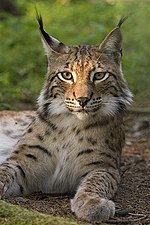Wikijunior:Big Cats/Lynx and bobcats

These odd-shaped, ruff-faced cats are not as lordly as the lion or powerful as the tiger. They are mid-sized predators, too big to bother with mice and too small to tackle a healthy adult deer. But they do one job rather well--keeping the rabbit population under control. With their long legs and short tails, they are superbly equipped to tackle anything from a tiny cottontail to a huge snowshoe hare. The natural enemies of the Iberian Lynx are the wolf and the bear but the most dangerous enemy that almost extincts it is the human that kills it with traps, venom and hunts them.
Where do lynx live?
[edit | edit source]
The four species of lynx are very widespread. The European Lynx lives in northern Europe and Asia. The Canadian Lynx lives in North America. The Iberian (or Spanish) Lynx is one of the most highly endangered cats and only lives in wild parts of Spain. Bobcats are the smallest type of lynx, living in North America. Because they hunt small prey, they live in a wide variety of habitats. The Iberian Lynx is an animal which lives only in the Iberian Peninsula.
What do lynx look like?
[edit | edit source]
Not all lynx look the same. Some of them have dark spots, while others have plain yellow or gray fur. All of them have white bellies. Lynx have long hairs at the tops of their ears, and a beard around their jaw. A bobcat is much smaller than a regular lynx. The lynx males weigh 40 pounds (18 kg) or more, and females weigh 18 to 30 pounds (8 to 14 kg), but the bobcat males only weigh 16 to 28 pounds (7 to 13 kg) and the females weigh 10 to 18 pounds (5 to 8 kg). The lynx also stands at 30 to 42 inches (74 to 107 cm) high, but the bobcat only is only 17 to 23 inches (43 to 58 cm) high. The bobcat also lacks the distinctive ear tufts and looks more like a big house cat. They have smaller feet and shorter legs compared to other lynx, and almost always have spots. The most unique part on the lynx and bobcat is their tail. The bobcat was named after its tail, because it is "bobbed" or short.
What do lynx and bobcats eat, and how do they catch their prey?
[edit | edit source]
Lynx eat mainly arctic hares (a large member of the rabbit family). They sometimes eat squirrels, ptarmigan (birds that look like large pigeons), and grouse (which look like fancy chickens). The Iberian Lynx feeds mostly on rabbits and hares.
Bobcats eat smaller animals like squirrels, rabbits, and mice. Their odd shape with long legs, a short neck and short tail, is an adaptation to hunting prey that must be captured with a sudden burst of speed and a killing pounce. In order to catch their prey, they must first sneak up as carefully and close as they can (stalking), and only make a final rushing attack when the prey makes a run for it. Obviously the closer they can approach before the run, the greater their chances of success.
They can't eat more than three pounds of meat at a time.
One common prey species for lynx, the arctic hare, has a secret weapon. Every year when the snow melts on the Arctic tundra (swampy grasslands) the timid animal sheds its white winter coat for a new crop of brown fur. This does not happen all at once, so while the hare still has patches of white, it still matches the surroundings where bits of snow still linger on the ground. By staying perfectly still, these hares are nearly impossible to see. This strategy often accomplishes a great deal more than running away.
Fun facts
[edit | edit source]To show their toughness, people used to claim that, in a fight, they could triumph over their "weight in bobcats". However, bobcat experts would not believe this claim for a moment. All cats are stronger for their size than any human.